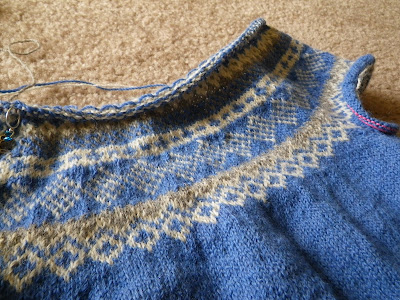I'm back in Greensboro, NC for a week of Master Spinning classes! I took Level 2 last year, and am taking level 3. So far it's been so fun spinning with lovely spinners from the area. The teacher is very talented and lots of fun.

Left to right, Lincoln @ 1.5TPI, Colored top @ 4TPI and 6TPI (in theory)
On the first day, our teacher handed us bits of red top and yellow top and asked us to spin to a specific tpi (twists per inch). The first one was a 6tpi yarn, and I seemed to get everywhere between 5.5-7.5 tpi except in one little inch.
The second yarn spun out of Lincoln (rough!) was a fat yarn with 1.5 tpi. That one came out better than the first, but I still need practice being consistent with my drafting.
The third yarn was spun at 4tpi, and that felt like the best yarn to date. There are definitely parts in that yarn that is not 4tpi, but it's close.
Then we did some math and confused every single neuron in our brains. It's simple algebra really, but with all the dimensional analysis for changing from metric to English and working backwards to get the proper tpi for singles, it got more confusing. Of course, there is an English system that has some arbitrary numbers (I'm sure it'll mean a lot later, but now, they don't mean anything) for different kinds of fibers and styles of spinning wool.
For example, a worsted wool yarn needs to be divided by 540 to get the number of skeins produced from a pound of prepped fiber. For woollen yarns it is 300 yards per skein. For silk and cotton it's 800. Right. What? Why? Why can't we do yards per pound to show how thick the yarn is? We can count up to 1000, right?
Anyway, the point of the lesson was to not only spin evenly and precisely, it was also to have a visual of the kind of yarn you want to spin in your mind. Thicker the yarn, less twist it needs, and less TPI there will be.
It was so exhausting thinking so hard about spinning, I took a long nap after class!
 Yes I've been scribbling around in Photoshop for few weeks now. Sorry professors! I sketched in photoshop. What a disgrace. But it helps to get my idea solidified. Now I'm going to cut some paper and fabric and see if that's a reasonable idea before I start knitting....after I find that 30 yards of red.
Yes I've been scribbling around in Photoshop for few weeks now. Sorry professors! I sketched in photoshop. What a disgrace. But it helps to get my idea solidified. Now I'm going to cut some paper and fabric and see if that's a reasonable idea before I start knitting....after I find that 30 yards of red.




















